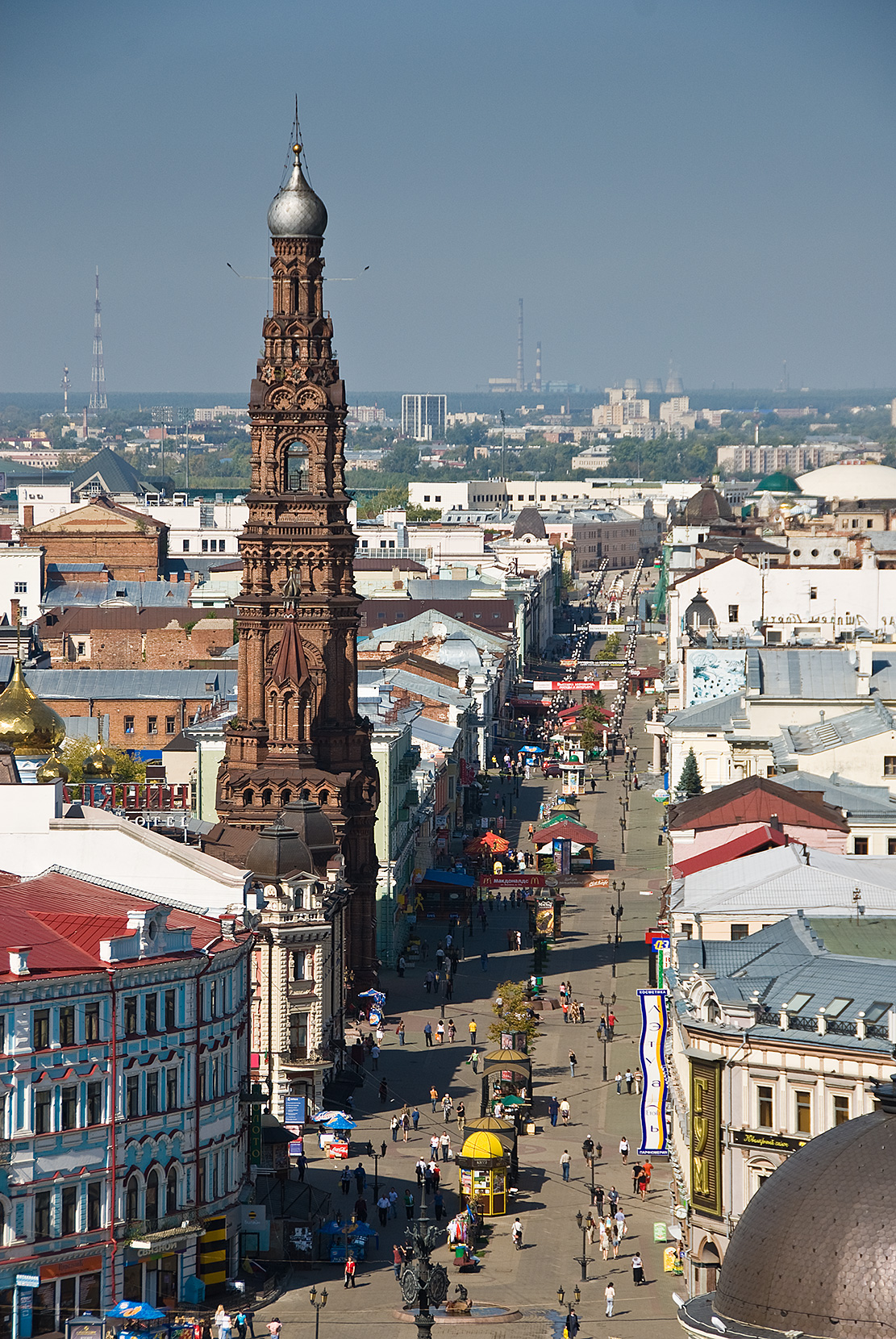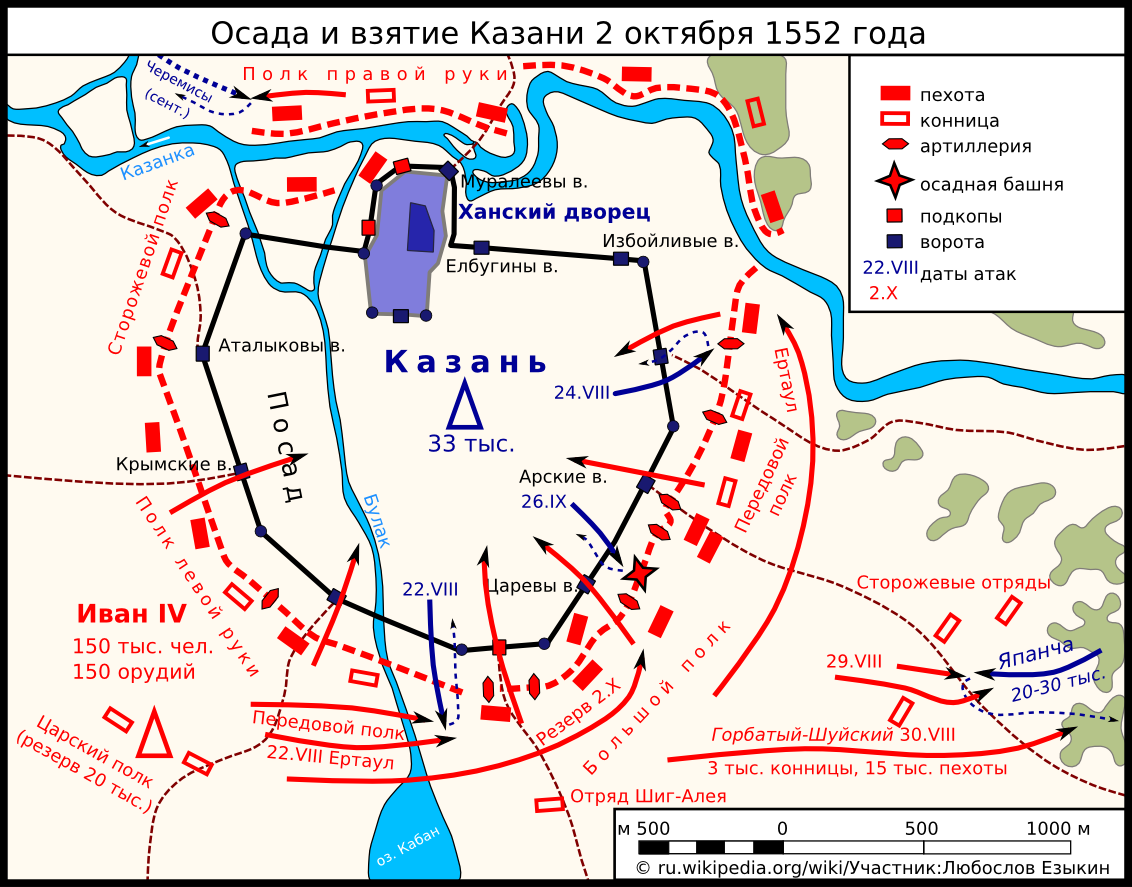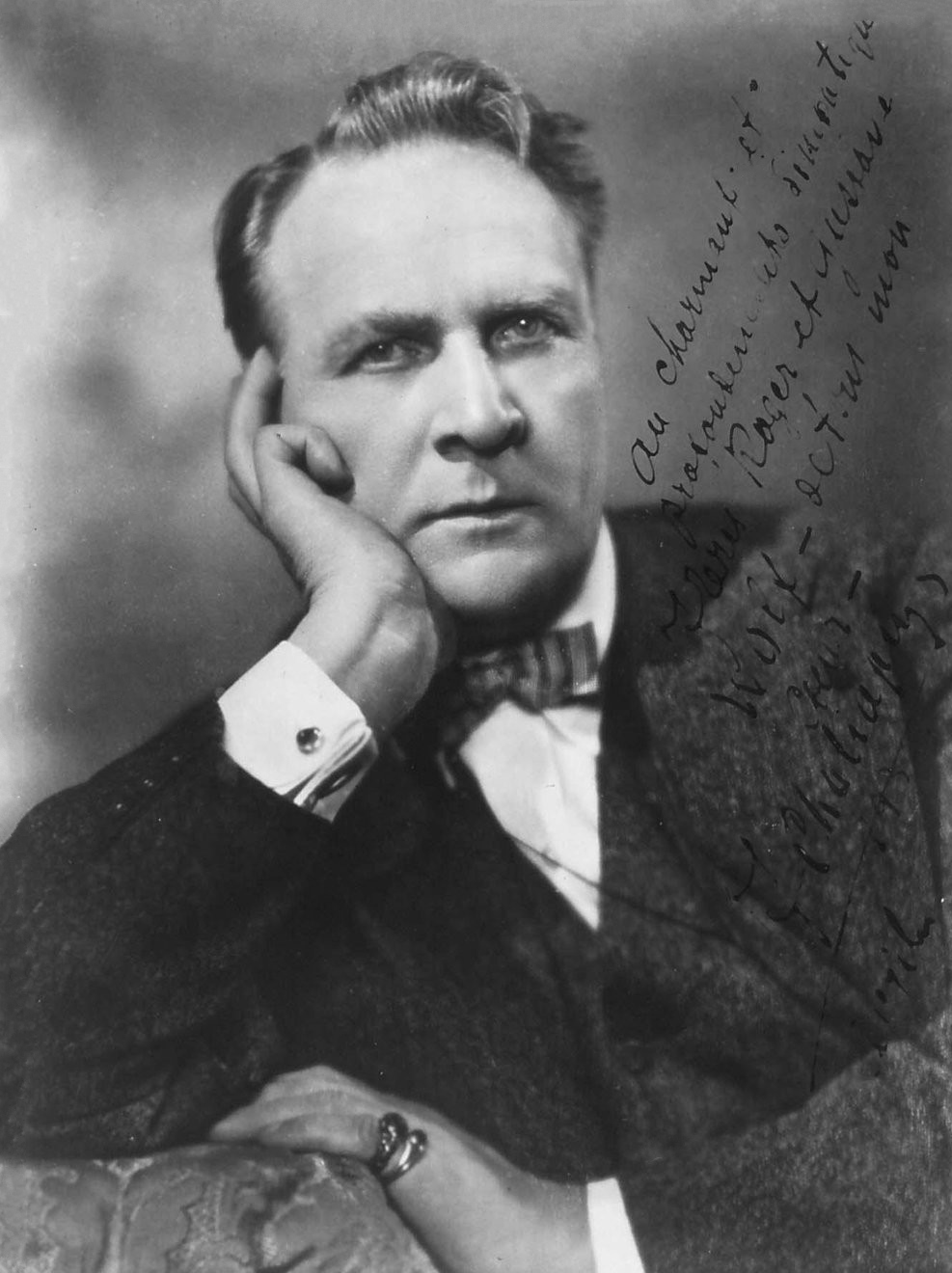|
Bauman Street (Kazan)
Bauman Street (russian: улица Баумана; tt-Cyrl, Бауман урамы) is a pedestrian street in the heart of Kazan, the capital of Tatarstan, Russia. It is named after Nikolay Bauman, a Russian revolutionary, and is located in the central part of the city. The street starts at the foot of the Kremlin and reaches Tukay Square, the central square in the city. Bauman Street is paved with multicoloured bricks; some benches and two lines of lanterns are set there. There are also planted lindens on the street. Different fairs and festive presentations are held on Bauman Street. History Bauman Street has long been regarded a trading centre and featured a concentration of the main mercantile establishments of the city. The street was the second most significant street of Kazan's central district. It was famous for its banks and notary offices, different shops, drugstores, and hotels. At the beginning of the twentieth century there was a shop in every building. Bauma ... [...More Info...] [...Related Items...] OR: [Wikipedia] [Google] [Baidu] |
Kazan
Kazan ( ; rus, Казань, p=kɐˈzanʲ; tt-Cyrl, Казан, ''Qazan'', IPA: ɑzan is the capital and largest city of the Republic of Tatarstan in Russia. The city lies at the confluence of the Volga and the Kazanka rivers, covering an area of , with a population of over 1.2 million residents, up to roughly 1.6 million residents in the urban agglomeration. Kazan is the fifth-largest city in Russia, and the most populous city on the Volga, as well as the Volga Federal District. Kazan became the capital of the Khanate of Kazan and was conquered by Ivan the Terrible in the 16th century, becoming a part of Russia. The city was seized and largely destroyed during Pugachev's Rebellion of 1773–1775, but was later rebuilt during the reign of Catherine the Great. In the following centuries, Kazan grew to become a major industrial, cultural and religious centre of Russia. In 1920, after the Russian SFSR became a part of the Soviet Union, Kazan became the capital of the Tat ... [...More Info...] [...Related Items...] OR: [Wikipedia] [Google] [Baidu] |
Tatarstan
The Republic of Tatarstan (russian: Республика Татарстан, Respublika Tatarstan, p=rʲɪsˈpublʲɪkə tətɐrˈstan; tt-Cyrl, Татарстан Республикасы), or simply Tatarstan (russian: Татарстан, tt-Cyrl, Татарстан), sometimes also called Tataria (russian: Татария, tt-Cyrl, Татария), is a Republics of Russia, republic of Russia located in Eastern Europe. It is a part of the Volga Federal District; and its capital city, capital and largest city is Kazan, an important cultural centre in Russia. The republic borders Kirov Oblast, Kirov, Ulyanovsk Oblast, Ulyanovsk, Samara Oblast, Samara, and Orenburg Oblasts, the Mari El Republic, Mari El, Udmurt Republic, Udmurt, and Chuvash Republics, and the Bashkortostan, Republic of Bashkortostan. The area of the republic is . The unofficial Tatarstan motto is ''Bez Buildırabız!'' (''We can!''). As of the Russian Census (2021), 2021 Census, the population of Tatarstan was& ... [...More Info...] [...Related Items...] OR: [Wikipedia] [Google] [Baidu] |
Russia
Russia (, , ), or the Russian Federation, is a List of transcontinental countries, transcontinental country spanning Eastern Europe and North Asia, Northern Asia. It is the List of countries and dependencies by area, largest country in the world, with its internationally recognised territory covering , and encompassing one-eighth of Earth's inhabitable landmass. Russia extends across Time in Russia, eleven time zones and shares Borders of Russia, land boundaries with fourteen countries, more than List of countries and territories by land borders, any other country but China. It is the List of countries and dependencies by population, world's ninth-most populous country and List of European countries by population, Europe's most populous country, with a population of 146 million people. The country's capital and List of cities and towns in Russia by population, largest city is Moscow, the List of European cities by population within city limits, largest city entirely within E ... [...More Info...] [...Related Items...] OR: [Wikipedia] [Google] [Baidu] |
Nikolay Bauman
Nikolay Ernestovich Bauman () ( – ) was a Russian revolutionary of the Bolshevik Party. His death in a struggle with a royalist upon his release from Taganka Prison in 1905 made him one of the first martyrs of the Revolution, and later of the Soviet Union. Biography Early life Bauman was born to the owner of a wallpaper and carpentry workshop, and a family of German origins. He attended the 2nd Kazan Secondary School, but dropped out in the 7th grade because of disagreements with his teachers. From 1891 to 1895, he was a student at the Kazan Veterinary Institute. During his student years he was fascinated by illegal populist and Marxist literature, and participated in various underground workers' groups. After receiving his diploma as a veterinary doctor, Bauman began work at the village of Novye Burasy in the Saratov Region and dreamt of becoming involved in revolutionary propaganda there. However, being known of by the police, and wishing to achieve broad revolutionary ... [...More Info...] [...Related Items...] OR: [Wikipedia] [Google] [Baidu] |
Kazan Kremlin
The Kazan Kremlin (russian: Казанский кремль, Kazanskiy kreml; tt-Cyrl, Казан кирмәне) is the chief historic citadel of Russia, situated in the city of Kazan. It was built at the behest of Ivan the Terrible on the ruins of the former castle of Kazan khans. It was declared a World Heritage Site in 2000. History and monuments The Kazan Kremlin includes many old buildings, the oldest of which is the Annunciation Cathedral (1554–1562), the only 16th-century Russian church to have six piers and five apses. Like many of Kazan's buildings of the period, it is constructed of local pale sandstone rather than of brick. The renowned Pskov architects Postnik Yakovlev and Ivan Shirjay (called Barma) were invited by the Tzar to rebuild the Kazan Kremlin in stone. The cathedral bell tower was erected in five tiers at the urging of Ivan the Terrible and was scored to resemble the Ivan the Great Belltower in Moscow, but was pulled down by the Soviets in 1930. ... [...More Info...] [...Related Items...] OR: [Wikipedia] [Google] [Baidu] |
Ğabdulla Tuqay
Ğabdulla Tuqay (tatar. ''عبد الله توقای,'' – ) was a Tatar poet, critic, publisher, and towering figure of Tatar literature. Tuqay is often referred to as the founder of the modern Tatar literature and the modern Tatar literary language, which replaced Old Tatar language in literature. Early life Ğabdulla Tuqay was born in the family of the hereditary village mullah of Quşlawıç, Kazan Governorate, Russian Empire (current Tatarstan, Russia) near the modern town of Arsk. His father, Möxämmätğärif Möxämmätğälim ulı Tuqayıv, had been a village ''mandative mullah'' since 1864. In 1885 his wife died, leaving him a son and a daughter, and Möxämmätğärif married second wife, Mämdüdä, daughter of Öçile village mullah Zinnätulla Zäynepbäşir ulı. On 29 August O.S. Möxämmätğärif died when Ğabdulla was five months old. Soon Ğabdulla's grandfather also died and Mämdüdä was forced to return to her father and then to marry the mullah of ... [...More Info...] [...Related Items...] OR: [Wikipedia] [Google] [Baidu] |
Fall Of Kazan
The siege of Kazan in 1552 was the final battle of the Russo-Kazan Wars and led to the fall of the Khanate of Kazan. Conflict continued after the fall of Kazan, however, as rebel governments formed in Çalım and Mişätamaq, and a new khan was invited from the Nogais. This guerrilla war lingered until 1556. Background During the existence of the khanate (1438-1552) Russian forces besieged Kazan at least ten times (1469, 1478, 1487, 1506, 1524, 1530, 1545, 1547, 1549-1550, 1552). In 1547 and in 1549-1550, Ivan the Terrible besieged Kazan, but supply difficulties forced him to withdraw. The Russians pulled back and built the town or fort of Sviyazhsk. They also annexed land west of the Volga which weakened the khanate. The peace party agreed to accept the pro-Russian Shah Ali as khan. The patriotic party regained power, Shah Ali fled and Yadegar Mokhammad of Kazan was called in as khan. Religious leaders like Qolsharif inspired the people to a determined resistance. The siege ... [...More Info...] [...Related Items...] OR: [Wikipedia] [Google] [Baidu] |
Ivan The Terrible
Ivan IV Vasilyevich (russian: Ива́н Васи́льевич; 25 August 1530 – ), commonly known in English as Ivan the Terrible, was the grand prince of Moscow from 1533 to 1547 and the first Tsar of all Russia from 1547 to 1584. Ivan was the son of Vasili III, the Rurikid ruler of the Grand Duchy of Moscow. He was appointed grand prince after his father's death, when he was three years old. A group of reformers known as the "Chosen Council" united around the young Ivan, declaring him tsar (emperor) of all Rus' in 1547 at the age of 16 and establishing the Tsardom of Russia with Moscow as the predominant state. Ivan's reign was characterised by Russia's transformation from a medieval state to an empire under the tsar but at an immense cost to its people and its broader, long-term economy. During his youth, he conquered the khanates of Kazan and Astrakhan. After he had consolidated his power, Ivan rid himself of the advisers from the "Chosen Council" and triggered the ... [...More Info...] [...Related Items...] OR: [Wikipedia] [Google] [Baidu] |
Fyodor Shalyapin
Feodor Ivanovich Chaliapin ( rus, Фёдор Ива́нович Шаля́пин, Fyodor Ivanovich Shalyapin, ˈfʲɵdər ɪˈvanəvʲɪtɕ ʂɐˈlʲapʲɪn}; April 12, 1938) was a Russian opera singer. Possessing a deep and expressive bass voice, he enjoyed an important international career at major opera houses and is often credited with establishing the tradition of naturalistic acting in his chosen art form. During the first phase of his career, Chaliapin endured direct competition from three other great basses: the powerful (1869–1942), the more lyrical (1871–1948), and Dmitri Buchtoyarov (1866–1918), whose voice was intermediate between those of Sibiriakov and Kastorsky. The fact that Chaliapin is far and away the best remembered of this magnificent quartet of rival basses is a testament to the power of his personality, the acuteness of his musical interpretations, and the vividness of his performances. Spelling note He himself spelled his surname, French-style ... [...More Info...] [...Related Items...] OR: [Wikipedia] [Google] [Baidu] |


.jpg)


